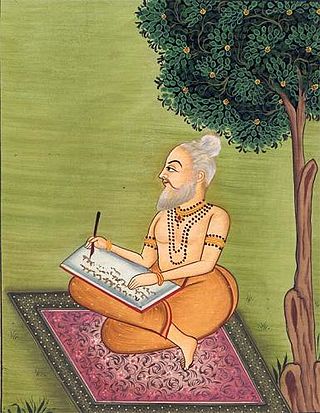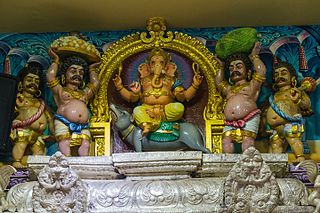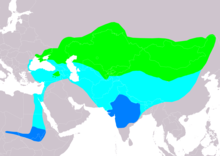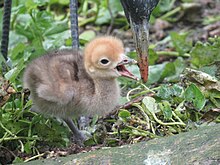
The Mahābhārata is one of the two major Smriti texts and Sanskrit epics of ancient India revered in Hinduism, the other being the Rāmāyaṇa. It narrates the events and aftermath of the Kurukshetra War, a war of succession between two groups of princely cousins, the Kauravas and the Pāṇḍavas.

Cranes are a type of large bird with long legs and necks in the biological family Gruidae of the order Gruiformes. The family has 15 species placed in four genera which are Antigone, Balearica, Leucogeranus, and Grus. They are large birds with long necks and legs, a tapering form, and long secondary feathers on the wing that project over the tail. Most species have muted gray or white plumages, marked with black, and red bare patches on the face, but the crowned cranes of the genus Balearica have vibrantly-coloured wings and golden "crowns" of feathers. Cranes fly with their necks extended outwards instead of bent into an S-shape and their long legs outstretched.

Valmiki was a legendary poet who is celebrated as the traditional author of the epic Ramayana, based on the attribution in the text itself. He is revered as Ādi Kavi, the first poet, author of Ramayana, the first epic poem.
Shloka or śloka (Sanskrit: श्लोक śloka, from the root श्रु śru, lit. 'hear' in a broader sense, according to Monier-Williams's dictionary, is "any verse or stanza; a proverb, saying"; but in particular it refers to the 32-syllable verse, derived from the Vedic anuṣṭubh metre, used in the Bhagavad Gita and many other works of classical Sanskrit literature.
Indian epic poetry is the epic poetry written in the Indian subcontinent, traditionally called Kavya. The Ramayana and the Mahabharata, which were originally composed in Sanskrit and later translated into many other Indian languages, and the Five Great Epics of Tamil literature and Sangam literature are some of the oldest surviving epic poems ever written.
Karuṇā is generally translated as compassion or mercy and sometimes as self-compassion or spiritual longing. It is a significant spiritual concept in the Indic religions of Hinduism, Buddhism, Sikhism, and Jainism.

The Vindhya Range is a complex, discontinuous chain of mountain ridges, hill ranges, highlands and plateau escarpments in west-central India.

The word gaṇa in Sanskrit and Pali means "flock, troop, multitude, number, tribe, category, series, or class". It can also be used to refer to a "body of attendants" and can refer to "a company, any assemblage or association of men formed for the attainment of the same aims". The word "gana" can also refer to councils or assemblies convened to discuss matters of religion or other topics.

Shambuka is a character in some editions of the Ramayana. Some say that the character and his story are an interpolation which is not found in the original Valmiki Ramayana but in a later addition called Uttara Kanda.

The haṃsa is an aquatic migratory bird, referred to in ancient Sanskrit texts which various scholars have interpreted as being based on the goose, the swan, or even the flamingo. Its image is used in Indian and Southeast Asian culture as a spiritual symbol and a decorative element. It is also used in a metaphorical sense with the bird attributed with the mythical ability to extract milk from a mixture of milk and water or good from evil. In Hindu iconography, hamsa is the vahana of Brahma, Gayatri, Saraswati, and Vishvakarma.

Grus is a genus of large birds in the crane family.
The Chinas are a people mentioned in ancient Indian literature, such as the Mahabharata, Manusmriti, and the Puranic literature.

Kishkindha is a kingdom of the vanaras in Hinduism. It is ruled by King Sugriva, the younger brother of Vali, in the Sanskrit epic Ramayana. According to the Hindu epic, this was the kingdom that Sugriva ruled with the assistance of his counsellor, Hanuman.

In Hindu cosmology, the Kshira Sagara or Ocean of Milk is the fifth from the centre of the seven oceans. It surrounds the continent known as Krauncha. According to Hindu scriptures, the devas and asuras worked together for a millennium to churn this ocean in order to acquire amrita, the elixir of immortal life. The episode is mentioned in the Samudra Manthana chapter of the Puranas, a body of ancient Hindu legends. The Kshira Sagara is described as the place where the deity Vishnu reclines over his serpent-mount Shesha, accompanied by his consort, Lakshmi.
An astra is a supernatural weapon in Hindu mythology. It is presided over by a specific deity and imbued with spiritual and occult powers that causes its effects.The term came to subsequently denote any weapon which was used by releasing it from one's hand, compared to keeping it one's hand.
The Mausala Parva is the sixteenth of the eighteen books of the ancient Indian epic Mahabharata. It traditionally has nine chapters. The critical edition has eight chapters. One of the 3 shortest books within the epic, the Mausala Parva describes the demise of Krishna in the 36th year after the Kurukshetra war had ended, the submersion of Dvaraka under sea, death of Balarama by drowning in the sea, Vasudeva's death, and a civil war fought among the Yadava clan that killed many of them. The story of infighting of the Yadavas becomes the reason why the Pandava brothers renounce their kingdom and begin their walk towards heaven, events recited in the last two books of the Mahabharata.

Kirātārjunīya is an epic poem by Bhāravi, written in Sanskrit. Believed to have been composed in the 6th century or earlier, it consists of eighteen cantos describing the combat between Arjuna and Shiva. Along with the Naiṣadhacarita and the Shishupala Vadha, it is one of the larger three of the six Sanskrit mahakavyas, or great epics. It is noted among Sanskrit critics both for its gravity or depth of meaning, and for its forceful and sometimes playful expression. This includes a canto set aside for demonstrating linguistic feats, similar to constrained writing. Later works of epic poetry followed the model of the Kirātārjunīya.
Svargarohana Parva or the Book of the Ascent to Heaven, is the last of eighteen books of the Indian epic Mahabharata. It traditionally has 6 chapters. The critical edition has 5 chapters. It is one of the shortest books in the Mahabharata.
A subhashita is a literary genre of Sanskrit epigrammatic poems and their message is an aphorism, maxim, advice, fact, truth, lesson or riddle. Su in Sanskrit means good; bhashita means spoken; which together literally means well spoken or eloquent saying.

















